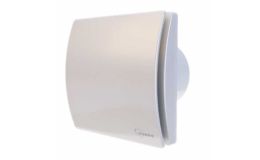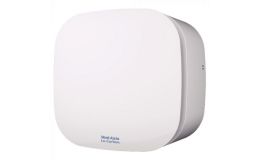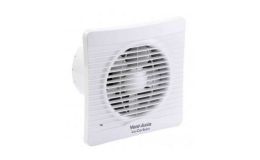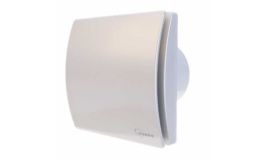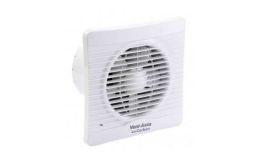Fastlec uses cookies to ensure that we give you the best experience on our website. If you continue we assume that you consent to receive all cookies on the Fastlec website. Read More.
Kitchen Extractor Fans
Extractor Fans for Kitchens
If you're looking for an extractor fan for your kitchen, then you’ve come to the right place!
We'll provide guidance on the types of fans available, as well as reviews of some of the best models on the market.
Choosing the Right Type of Extractor Fan.
Before selecting an extractor fan, you need to consider the type of fan that will best suit your needs. There are several different types to choose from depending on where and how you want to install them. For example, wall-mounted fans provide ventilation in confined spaces, while ceiling fans are great for removing steam, smells, and odours from larger kitchens. You should also consider whether you need a variable speed fan, a timer fan, or what kind of noise levels you're comfortable with.
Identifying Your Installation Needs.
Consider the size and type of kitchen you’ll be installing an extractor fan in, as this will determine your preferred option. Wall-mounted fans are best for confined spaces, while ceiling fans are great for removing steam from larger kitchens. You should also think about where you want to install the fan in order to get the best results - do you need a fan close to your cooker or hob? Or maybe one that can fit over a sink? Figuring out installation requirements early on will help inform your buying decision.
Comparing Features and Prices.
Different types of kitchen fans can offer various features, and it’s important to know what your budget allows before committing to a purchase. Consider the power and speed ratings of the fan in order to figure out which one is right for you. Some models may be more effective at eliminating steam and odours, while others might have extra useful features like automatic shut-off timers or adjustable speeds. Equally important is checking the price point; higher-priced fans may provide better value for money in comparison to cheaper models depending on the features they offer.
Checking for Energy Efficiency Rating Ratings (EER).
When browsing for an extractor fan for your kitchen, it’s important to check the energy rating of the model. Look for the EER rating which indicates how much energy the fan consumes compared to its output. The higher the rating, usually between 2 and 3, the more efficient the fan is likely to be. This is useful information if you're looking to install a fan in an area with limited ventilation and don't want to waste too much energy with frequent uses.
Reading Reviews from Real Customers.
An easy way to narrow down your options is by looking for reviews from real customers. Reviews provide insight into the customer experience in a way that can’t always be replicated in testing labs. Reading customer reviews on products can provide useful feedback on noise levels, airflow rating, and whether the fan is built to last, as well as other key factors when choosing an extractor fan. Pay attention to any common problems that existing customers have had with a product before you make a purchase.
Kitchen Extractor Fan Q&A
Q: Do kitchen extractor fans need to vent outside?
A: Yes, kitchen extractor fans need to be vented outside so the air (and odours) can escape the home. Properly installed and maintained kitchen extractor fans will help to improve air circulation and reduce humidity levels in your kitchen for a safe and comfortable cooking environment.
Q: What Is The Best Extractor Fan For Kitchens?
A: The best type of extractor fan to use in the kitchen depends on the size of your kitchen and the amount of air you need to move. Generally, a wall-mounted fan is recommended for smaller kitchens, while larger areas are best served by ceiling-mounted fans with more powerful motors. To ensure maximum efficiency, it’s best to buy an extractor fan that has been rated with a high airflow rating.
Q: Cooker Hoods vs Extractor Fans - What's the Difference?
A: Cooker hoods are positioned above cookers, stovetops, and hobs and mainly serve to tackle grease and steam. On the other hand, an extractor fan is often operated near a window or bolted through to the outside wall of your home. Most commonly used in bathrooms and kitchens, an extractor works by sucking the air out of these high-humidity areas filled with odours.
Q: Do you need an electrician to install a kitchen extractor fan?
A: Yes, you will usually need an electrician to install a kitchen extractor fan. The electrician will ensure that the unit is securely and safely mounted and wired, and will be able to advise on any additional safety devices that may be needed such as fuse boxes.
Q: Do I need to open the window if I have an extractor fan?
A: No, a kitchen extractor fan is designed to remove air from the room, so there should be no need to open windows. However, make sure to regularly clean your extractor fan and check that it’s not blocked to ensure the best performance.
Q: Do extractor fans use much electricity?
A: Most extractor fans will use between 20-150 watts of power when running, depending on the size and type of fan. To calculate how much electricity your extractor fan is using, you can multiply its wattage by the number of hours it runs in a day.
Q: Where is the best place to put an extractor fan?
A: To ensure your kitchen extractor fan works effectively, it’s a good idea to install it near the source of steam and cooking odours. It is best to install it in an area of the kitchen that won’t be disrupted by furniture or cabinets, such as walls, ceilings, or windows.
Q: How do you vent a kitchen with no outside access?
A: There are several solutions for venting kitchens without outside access, such as using powered extractor fans with ducts that pass through the roof space, or installing extractor hoods that expel air back into the room. Cavity wall fans are also available and can be used to draw air from one room and expel it in another.
Kitchen Extractor Fans - Recommended Range
There is a huge choice of fans in our range, many of which could be successfully employed in a kitchen and deciding which one to go with can be a daunting process. To help make the choice easier for the majority of customers we have brought together in this category both the most popular fans purhcased for kitchen use and the fans that we would most recomend for this application.
Kitchen Extractor Fans - Choose One Big Enough For Your Kitchen
The main job of a kitchen fan is to remove odors, moisture, grease and air effectively. In simple terms, the bigger your kitchen, the bigger the fan you need, as the recomended air changes per hour are a minimum of 15. For example, if your kitchen which is 14.44m cubed and has a fan that performs at 260m cubed per hour, it should change the air in the kitchen 18 times per hour. The more powerfull your stove and the more cooking you do, the more you should try and increase your air changes if you can.
Axial, Centrifugal and Mixed-Flow Kitchen Fans
150mm axial fans such as the Vortice Punto range are fine for extracting straight through a kitchen wall to the outside. If you have longer duct runs to the outside then centrifugal wall fans such as the Vortice Quadro or the Vent Axia Centrif Duo can move the air over much longer distances. Also, mixed flow fans such as the Airflow iCON60 can move large amounts of air over long duct runs using a combination of axial and centrifugal technology within the same wall fan. If you have a ceiling void then inline fans such as the Vortice Lineo can provide the most effective kitchen ventilation without having to have a large fan stuck on your kitchen wall.
Nearly all the fans here can come with control options such as pullcord, timer, humidity, PIR, dual speed etc..
- In stock
- Due Back in Stock 31st July 2024
- In stock
- In stock
- In stock
- Due Back in Stock 9th August 2024
- In stock
- In stock
- In stock
- In stock
- In stock
- In stock


